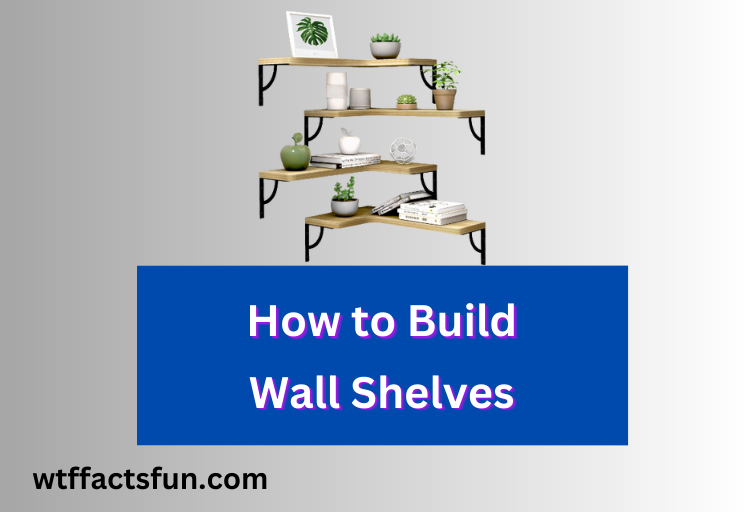
Table of Contents
- 1 How to Build Wall Shelves
- 2 Introduction to Wall Shelves
- 3 1. Selecting the Right Location
- 4 2. Choosing the Shelf Design
- 5 3. Gathering Materials and Tools
- 6 4. Taking Accurate Measurements
- 7 5. Preparing the Shelves
- 8 6. Assembling the Shelves
- 9 7. Mounting the Shelves
- 10 8. Adding Finishing Touches
- 11 9. Maintaining and Decorating Your Wall Shelves
- 12 Conclusion
- 13 FAQs (Frequently Asked Questions)
How to Build Wall Shelves
How to Build Wall Shelves: Wall shelves are not just practical storage solutions; they also add a touch of elegance and organization to your living space. Whether you’re a DIY enthusiast or a beginner, building wall shelves can be a rewarding project that enhances both the functionality and aesthetics of your home. In this article, we will walk you through the process of creating your very own wall shelves that are not only sturdy but also a perfect fit for your decor.
Introduction to Wall Shelves
Wall shelves serve as both functional storage and stylish decor elements. They can be customized to fit any room, whether it’s your living room, bedroom, kitchen, or even bathroom. Building your own wall shelves allows you to create a unique and personalized solution that meets your specific needs.
1. Selecting the Right Location
Before you start building, consider where you want to install the shelves. Identify areas that could use extra storage or visual interest, such as empty walls or corners.
2. Choosing the Shelf Design
There are various designs to choose from, each offering a distinct aesthetic:
1. Floating Shelves
Floating shelves create a minimalist and contemporary look. They appear to “float” on the wall without visible brackets, providing a sleek and uncluttered appearance.

2. Bracket Shelves
Bracket shelves use brackets for support, which can be decorative or functional. These shelves can accommodate heavier items and come in a range of styles.

3. Corner Shelves
Corner shelves utilize often overlooked spaces and are perfect for displaying decorative items or storing essentials without taking up valuable floor space.

3. Gathering Materials and Tools
Based on your chosen design, gather the necessary materials, including wood boards, brackets (if applicable), screws, a drill, a level, a measuring tape, and a stud finder.
4. Taking Accurate Measurements
Measure the length, width, and depth of the space where you intend to install the shelves. Accurate measurements ensure that your shelves fit perfectly and look balanced.
5. Preparing the Shelves
If you’re using raw wood, sand the edges and surfaces to achieve a smooth finish. You can also paint or stain the shelves to match your decor.
6. Assembling the Shelves
Follow the manufacturer’s instructions to assemble the shelves and brackets. If you’re building floating shelves, create support structures inside the shelves that will attach securely to the wall.
7. Mounting the Shelves
Using a stud finder, locate the wall studs and mark their positions. Secure the brackets or support structures to the wall studs for maximum stability.
8. Adding Finishing Touches
Once the shelves are securely mounted, step back and admire your handiwork. Arrange your items on the shelves, taking care to balance the visual weight and spacing.
9. Maintaining and Decorating Your Wall Shelves
Regularly dust and clean your wall shelves to keep them looking their best. You can also enhance the shelves with decorative items like plants, artwork, or small sculptures.
Conclusion
Building wall shelves is a gratifying project that allows you to showcase your creativity and enhance the functionality of your living space. By carefully selecting the design, materials, and location, you can create wall shelves that seamlessly integrate with your decor while providing valuable storage solutions.
FAQs (Frequently Asked Questions)
How do you make a simple wall shelf?
To make a simple wall shelf, you’ll need a wooden board, brackets, screws, a drill, and a level. Attach the brackets to the wall and then mount the board on top for an easy and functional DIY shelf.
Is it cheaper to build your own shelves?
Building your own shelves can often be more cost-effective than purchasing pre-made ones, as it allows you to choose materials and customize sizes according to your budget and needs.
Is plywood stronger than wood for shelves?
Plywood is generally considered stronger than solid wood for shelves due to its layered construction, which enhances its resistance to warping and provides consistent strength across the entire surface.
What is the best material for built in shelves?
The best material for built-in shelves is typically hardwood, as it offers both durability and a refined appearance that complements various interior designs. Alternatively, engineered wood like MDF can also be a suitable option for a balance between cost and quality.
Can I use plywood to make shelves?
Yes, plywood can be used to create shelves. It’s a versatile material known for its durability and cost-effectiveness, making it a popular choice for DIY shelf projects.
Read also:
A Step-by-Step Guide on How to Make Bronze Statues
27 Best Facts About Zimbabwe Economy
Unveiling the Truth About “Free V Bucks Generator”: Fact or Fiction?